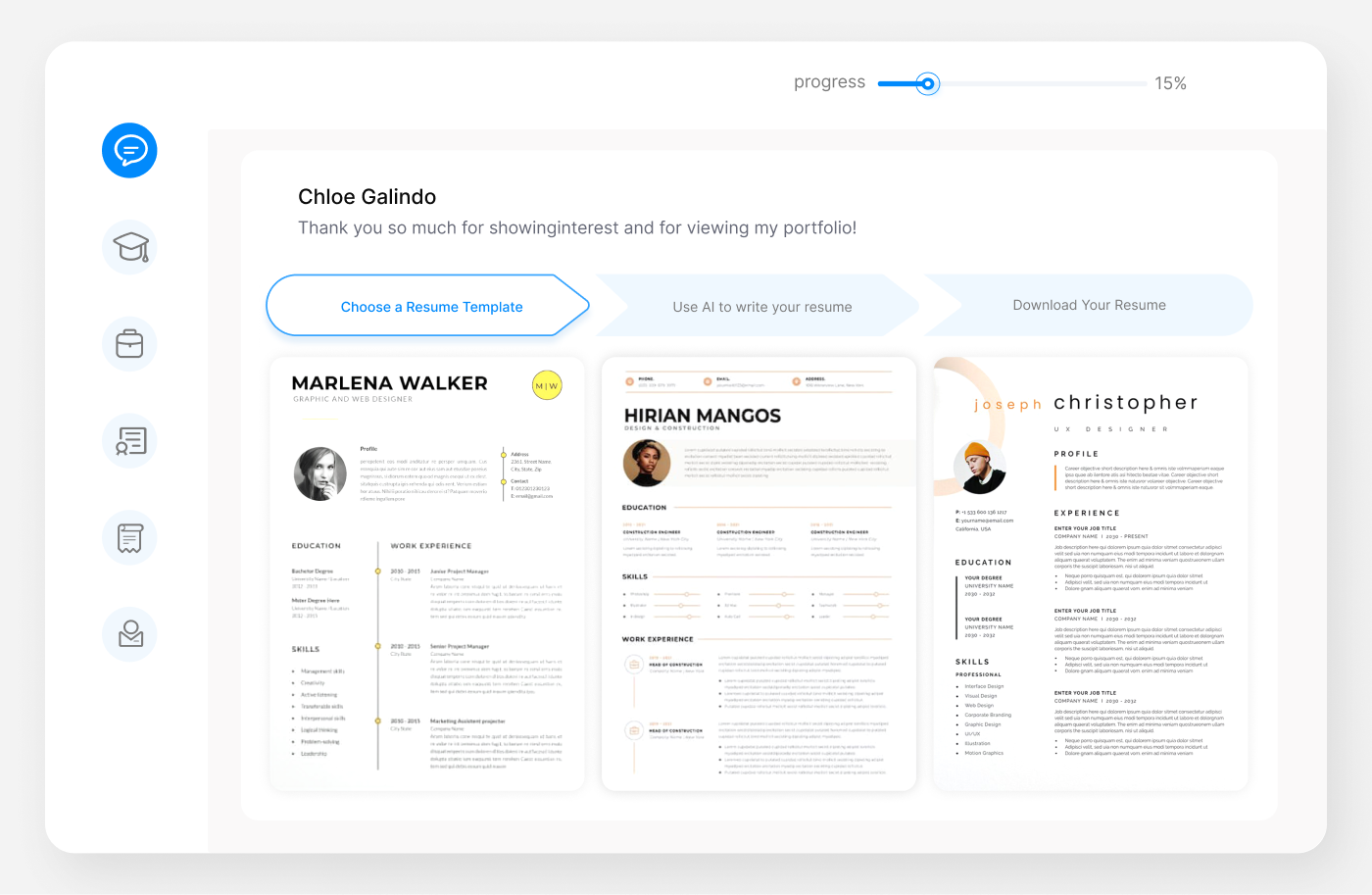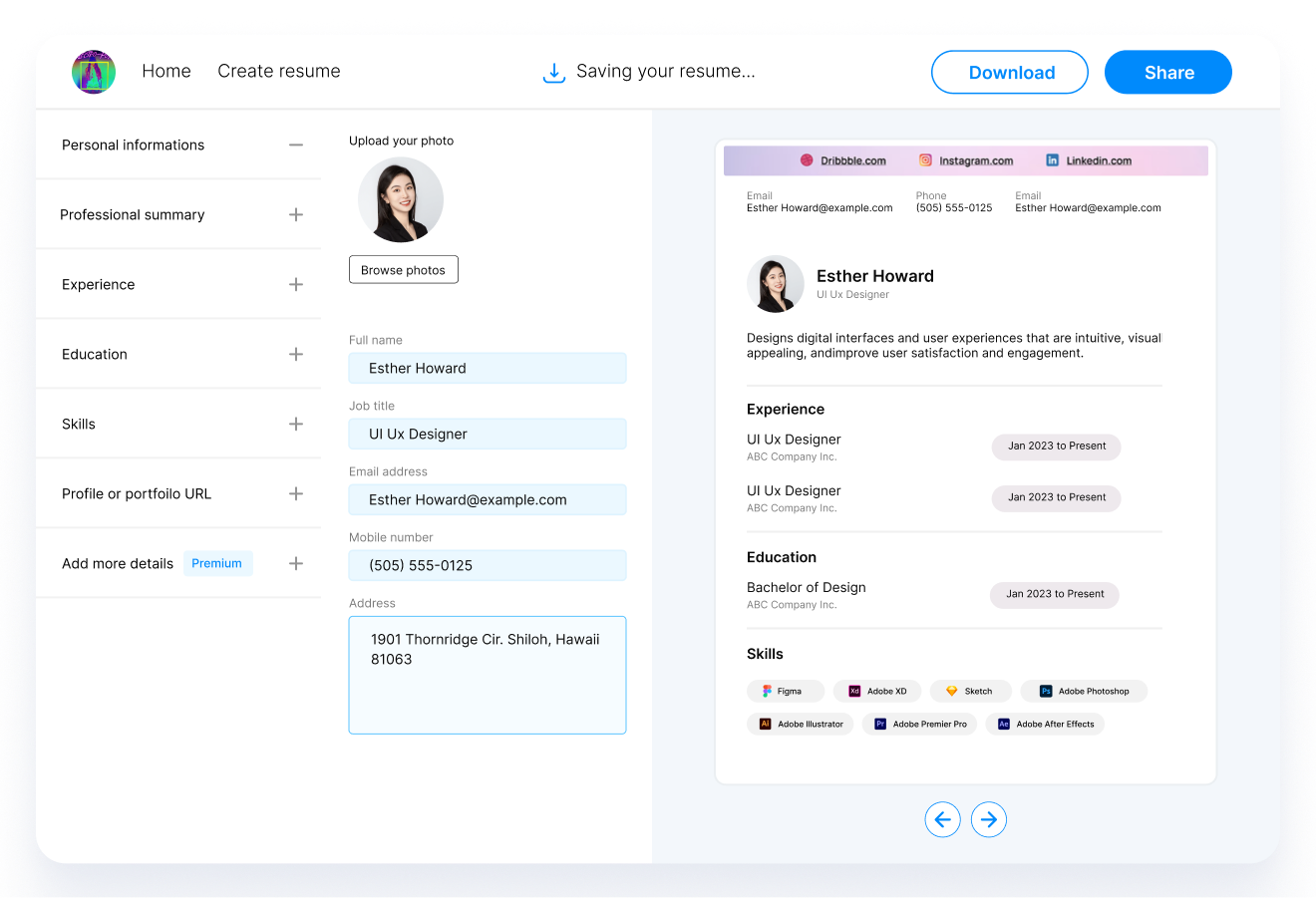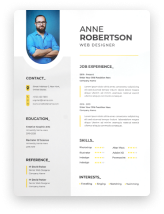In this guide, we delve into the intricacies of writing an exceptional resume for a machinist role in the Manufacturing & Warehousing sector. As machinists play a pivotal role in the manufacturing process, their resumes need to mirror their precision and expertise. This guide will walk you through each step of crafting a resume that not only showcases your skills and experience but also speaks directly to the needs of employers in this dynamic industry.

Crafting the Perfect Machinist Resume: A Real-World Example
Samantha Lopez Machinist
Contact: 555-123-4567 | samantha.lopez@email.com
LinkedIn: linkedin.com/in/samanthalopez
Summary:
Detail-oriented and precision-focused Machinist with over 5 years of experience in CNC operation, manual machining, and CAD/CAM programming. Proven track record in improving production efficiency and accuracy in high-volume manufacturing environments. Adept at interpreting blueprints and executing complex machining processes with a commitment to quality and safety.
Professional Experience:
Lead CNC Machinist Advanced Manufacturing Co.
Houston, TX | May 2019 -- Present
-
Supervise a team of 5 machinists, overseeing CNC operations for automotive component production.
-
Innovated a tooling modification that increased production efficiency by 20%.
-
Manage machine maintenance, reducing downtime by 15%.
CNC Machinist Precision Parts Inc., Dallas, TX
June 2015 -- April 2019
-
Operated CNC machines to produce aerospace components, maintaining a 99.8% accuracy rate.
-
Collaborated in the design of new jigs and fixtures, improving overall production time by 10%.
-
Conducted regular training sessions for new staff on machine operation and safety protocols.
Education:
A.A.S. in Precision Machining Technology
Texas State Technical College, Waco, TX
Graduated May 2015
Skills:
-
CNC Machine Operation
-
Manual Machining
-
CAD/CAM Programming
-
Blueprint Interpretation
-
Quality Control
-
Safety Compliance
-
Team Leadership
Certifications:
-
Certified CNC Machinist (National Institute for Metalworking Skills)
-
OSHA Safety Certification
Enhancing Your Resume's Impact: Effective Structure and Layout
When crafting a resume for a machinist position, the structure and layout play a crucial role in showcasing your qualifications effectively. A well-organized resume not only makes it easier for hiring managers to find the information they need but also highlights your professionalism and attention to detail -- key traits for a machinist.
The Anatomy of a Well-Structured Machinist Resume
1. Header: Start with a clean header including your name, job title (Machinist), and contact information. Make sure it's easy to find and read.
2. Summary or Objective: A brief, impactful section that summarizes your experience and skills, tailored to machinist roles. This is your elevator pitch, so make it count.
3. Work Experience: List your previous jobs in reverse chronological order. Focus on achievements and responsibilities that relate directly to machinist duties. Quantify your accomplishments where possible, such as "increased production efficiency by 20%."
4. Education: Include relevant educational background, particularly any machining or engineering-related qualifications. Technical certifications or apprenticeships are also valuable here.
5. Skills: Highlight specific skills that are essential for a machinist, such as CNC operation, precision measurement, and blueprint reading. Tailor this section to match the job description.
6. Additional Sections: Consider adding sections for certifications, awards, or volunteer work, especially if they demonstrate skills or qualities relevant to machining.
Formatting Tips for Clarity and Readability
-
Consistency: Use the same font and formatting throughout your resume. This includes font size, bullet points, and headings.
-
Whitespace: Adequate spacing makes your resume more readable. Avoid clutter and use bullet points for lists.
-
Length: Aim for one page if you have less than 10 years of experience. For more experienced machinists, two pages can be acceptable.
-
File Format: Use PDF to maintain formatting across different devices, unless specified otherwise in the job posting.
Crafting a Compelling Resume Summary or Objective for Machinists
The resume summary or objective is a crucial element, serving as your first opportunity to capture the hiring manager's attention. For a machinist, this section should concisely showcase your skills, experience, and what you bring to the table. Here's how to craft a compelling summary or objective:
Resume Summary for an Experienced Machinist
Ideal for those with several years of experience in machining: Highlight your key achievements, skills, and what you can contribute to the prospective employer. Focus on specific experiences that demonstrate your expertise in machining.
"Dedicated and precision-focused machinist with over 8 years of experience in CNC programming and operation. Proven track record in enhancing production efficiency and accuracy, skilled in advanced CAD/CAM technology, and committed to maintaining high safety standards."
Resume Objective for an Entry-Level Machinist
Ideal for newcomers or those shifting careers: Instead of extensive experience, focus on your career goals, relevant skills, and how they align with the job requirements. Showcase your enthusiasm and potential.
"Aspiring machinist with a strong foundation in CNC operation and CAD/CAM programming from extensive coursework and hands-on training. Eager to apply my technical skills and commitment to precision in a challenging manufacturing environment"
Tips for Writing an Effective Summary or Objective
-
Tailor it to the Job: Customize your summary or objective to align with the specific requirements of the machinist position you're applying for.
-
Be Specific: Use concrete examples and quantify achievements where possible.
-
Keep it Concise: Aim for 3-4 impactful sentences.
-
Focus on Value: Highlight how you can contribute to the employer, not just what you want out of the job.
Detailing Your Work Experience: A Machinist's Guide
The Work Experience section is where you get to showcase your professional journey and achievements. For a machinist's resume, it's important to detail your experiences in a way that highlights your skills, precision, and contributions to past employers. Here's how to structure this section effectively:
How to List Your Machinist Work Experience
1. Reverse Chronological Order: Start with your most recent job and work backwards. This format is preferred by employers as it provides a clear picture of your career progression.
2. Job Title, Employer, and Dates: Clearly state your job title, the company's name, and the duration of your employment.
3. Responsibilities and Achievements: For each role, list your key responsibilities and achievements. Focus on tasks that are relevant to a machinist's role and use action verbs to start each point.
- "Operated and maintained CNC machinery, achieving a 99.7% accuracy rate in produced parts."
- "Collaborated on a project to improve machine efficiency, resulting in a 15% reduction in production time."
Tips for Highlighting Machinist Work Experience
-
Quantify Your Impact: Wherever possible, use numbers to quantify your achievements, such as efficiency improvements or accuracy rates.
-
Tailor to the Job Description: Align your experience with the skills and requirements listed in the job description you're applying for.
-
Focus on Relevant Skills: Highlight experiences that showcase your machining skills, technical knowledge, and any specialty areas like CNC programming or precision machining.
Navigating the Education Section for Machinists
The Education section on a machinist's resume is a vital component, particularly in a field where technical know-how and precision are paramount. Here's how to effectively present your educational background:
Presenting Your Educational Background
1. List of Qualifications: Include any degrees, diplomas, or certificates relevant to machining. Focus on programs that have equipped you with the skills needed in a machinist role.
2. Technical and Vocational Training: If you have undergone specialized training, such as CNC programming or precision machining courses, make sure to highlight these.
3. Recent Graduates: If you're newly entering the field, place more emphasis on your education. Include details like relevant coursework, projects, or extracurricular activities that demonstrate your skills and interest in machining.
A.A.S. in Machining Technology
Houston Community College, Houston, TX
Graduated May 2022
- Key Courses:
- CNC Programming
- Precision Machining
- CAD/CAM, Machine Tool Operation
Tips for the Education Section
-
Relevance is Key: Focus on education and training that is directly relevant to a machinist's role.
-
Continuing Education: If you have pursued any continuing education or professional development courses, include them to show your commitment to staying current in the field.
-
Certifications: Include any industry-recognized certifications, such as the National Institute for Metalworking Skills (NIMS) certification, as these can be particularly appealing to employers.
Your Education section should mirror your professional readiness and your dedication to the craft of machining.
Highlighting Skills for a Machinist Resume
In the Skills section, you get to showcase the specific abilities that make you a great fit for a machinist role. This section should be a mix of technical competencies and soft skills relevant to the manufacturing and warehousing sector.
Essential Skills for a Machinist
1. Technical Skills: Include specific machinist skills like CNC programming, manual machining, precision measurement, and blueprint reading. Highlight your proficiency with different machinery and tools.
2. Soft Skills: Machinists also need strong problem-solving skills, attention to detail, and the ability to work in a team. These are just as important as technical skills.
3. Safety and Quality Control: Emphasize your knowledge of safety protocols and quality control standards, which are crucial in a manufacturing environment.
- CNC Programming and Operation
- Manual Lathe and Milling Machine Operation
- Precision Measurement and Quality Control
- Blueprint Reading and Interpretation
- Team Collaboration and Communication
- Strong Problem-Solving Abilities
- Adherence to Safety Standards
Tips for the Skills Section
-
Tailor to the Job Description: Match your skills with the requirements listed in the job posting. This shows you're a good fit for the role.
-
Be Specific: Instead of general terms like "machining skills," list specific abilities and machinery you're experienced with.
-
Balance Technical and Soft Skills: While technical skills are key, don't underestimate the importance of soft skills in a collaborative work environment.
This section is your opportunity to highlight the unique skills that make you an ideal candidate for a machinist position.
Adding Value with Additional Sections on a Machinist Resume
In addition to the standard sections, consider including additional categories that can provide a more comprehensive view of your qualifications as a machinist. These sections can set you apart from other candidates by showcasing your broader skills and experiences.
Suggestions for Additional Sections
1. Certifications: Include any relevant certifications, such as CNC machining certificates or safety training, that enhance your qualification for the role.
2. Awards and Honors: If you've received any awards or honors, especially those related to machining or manufacturing, they can add credibility to your resume.
3. Volunteer Experience: Volunteer work, particularly if it's related to the industry or demonstrates relevant skills, can be a great addition.
4. Projects: For those with less work experience, listing specific projects (e.g., in a school or training setting) where you applied machining skills can be beneficial.
5. Professional Affiliations: Membership in professional organizations or industry groups can indicate your commitment to the field.
Certifications:
- National Institute for Metalworking Skills (NIMS) Machining Level 1
Projects:
- Collaborated on a team project to design and manufacture a small-scale CNC router, improving design efficiency by 30%.
Volunteer Experience:
- Volunteered at local community center, teaching basic machining and safety practices to beginners.
Tips for Additional Sections
-
Relevance is Key: Ensure that whatever you include in these sections is relevant to the machinist role and adds value to your profile.
-
Be Concise: While these sections are important, keep them brief and to the point, focusing on the aspects that highlight your suitability for the job.
By thoughtfully including these additional sections, you can provide a fuller picture of your capabilities and experiences, making your resume stand out.
The Art of Writing a Machinist Cover Letter
Alongside your resume, a well-crafted cover letter can significantly boost your chances of landing a machinist position. This is your opportunity to provide a more personal touch and directly address the employer.
Key Elements of a Machinist Cover Letter
1. Tailored Introduction: Start by addressing the hiring manager by name, if possible. Mention the specific machinist role you're applying for and where you found the job listing.
2. Showcase Your Skills and Experience: Highlight your most relevant experiences and skills as a machinist. Relate them directly to the job description to demonstrate how you're a perfect fit for the role.
3. Personal Touch: Share why you're interested in the role and the company. This can be based on your passion for machining, the company's reputation, or its products and services.
4. Call to Action: End with a proactive statement, expressing your eagerness to discuss your application in an interview.
"Dear [Hiring Manager's Name],
I am writing to express my interest in the Machinist position at [Company Name], as advertised on [Where you found the job listing]. With over 5 years of experience in CNC machining and a proven track record in improving production efficiency, I am excited about the opportunity to contribute to [Company's] renowned manufacturing team..."
Tips for an Effective Cover Letter
-
Be Specific: Tailor your cover letter for each job application. Generic letters are easy to spot and often less effective.
-
Keep it Concise: Aim for a single page. Highlight key points without repeating everything in your resume.
-
Professional Tone: Maintain a professional but engaging tone. Show enthusiasm for the role and the industry.
Final Touches: Concluding Your Machinist Resume
The concluding section of your machinist resume is an opportunity to leave a lasting impression on the employer. It should reinforce your suitability for the role and summarize the key points that make you an ideal candidate.
Elements to Include in the Conclusion
1. Reiterate Key Strengths: Briefly restate your most important skills and experiences that align with the machinist role. This is a chance to reinforce your value proposition.
2. Express Enthusiasm: Show your genuine interest in the role and the company. Employers are looking for candidates who are not just qualified but also passionate about their work.
3. Professional Readiness: Indicate your readiness for the next step, whether it's an interview or further discussion. This shows your proactive attitude.
Tips for an Effective Conclusion
-
Be Concise: Keep this section brief and impactful. You've already provided details in the earlier sections.
-
Tailor to the Job: Customize this part to reflect the specific machinist role and the company you are applying to.
-
Call to Action: End with a statement that invites further action, such as an interview or a discussion.
A well-crafted conclusion can be a powerful tool in your resume, summarizing your fit for the machinist role and leaving a positive final impression.

Key Takeaways: Mastering Machinist Resume Writing
In wrapping up this comprehensive guide on crafting a machinist resume, let's summarize the key points that will help you create a resume that stands out in the competitive manufacturing and warehousing job sector.
Essential Elements of a Successful Machinist Resume
-
Clear Structure: Organize your resume with distinct sections for ease of reading. A well-structured resume reflects your ability to handle detailed work.
-
Relevant Experience: Highlight your machinist experience, focusing on achievements that showcase your skills and impact on previous roles.
-
Technical Proficiency: Detail your technical skills, especially those directly related to machining, such as CNC programming and precision measurement.
-
Education and Training: Include relevant educational qualifications and any specialized training or certifications you have in machining.
-
Soft Skills and Additional Qualities: Don't forget to mention soft skills like problem-solving and teamwork, as well as any additional sections that add value to your profile.
-
Customization: Tailor your resume for each application to align with the specific requirements of the job.
-
Professional Presentation: Ensure your resume is error-free, well-formatted, and professionally presented.
Final Thoughts
Your resume is a reflection of your professional journey as a machinist. It should not only showcase your technical abilities but also demonstrate your commitment to quality and efficiency, key traits in the manufacturing sector. Remember, a well-crafted resume opens the door to new opportunities and is your first step towards a successful career as a machinist.
With these insights and tips, you are now equipped to create a machinist resume that effectively communicates your value to potential employers.
FAQ about Crafting a Machinist Resume
Including a Frequently Asked Questions (FAQ) section in your machinist resume guide can address common concerns and provide additional clarity for job seekers. Here are some potential questions and answers:
Frequently Asked Questions
Q1: How long should my machinist resume be?
- A1: Aim for one page if you have less than 10 years of experience. For those with more extensive experience, a two-page resume can be appropriate.
Q2: Should I include references on my resume?
- A2: It's not necessary to include references on your resume. Have them ready upon request.
Q3: How can I make my resume stand out?
- A3: Tailor your resume to the job description, use a clear format, and highlight specific achievements and skills that are relevant to a machinist role.
Q4: What if I don't have much experience as a machinist?
- A4: Focus on relevant coursework, projects, or volunteer experiences that demonstrate your skills and interest in machining.
Q5: Is it important to include soft skills on a machinist resume?
- A5: Yes, soft skills like teamwork, problem-solving, and communication are important and should be included alongside technical skills.
Q6: Can I include part-time jobs on my resume?
- A6: Yes, if they are relevant or demonstrate skills applicable to the machinist role.
Q7: How often should I update my resume?
- A7: Regularly update your resume, especially when you gain new skills, certifications, or experiences relevant to machining.
This FAQ section can serve as a quick reference for common questions, helping job seekers craft an effective resume for a machinist position.
Recommended Reading






